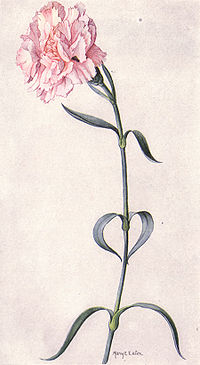National Geographic Magazine/Volume 31/Number 6/Our State Flowers/The Carnation
Our State Flowers[edit]
The Carnation (Dianthus caryophyllus L.)[edit]

PINK CARNATION
Dianthus caryophyllus L.
This beautiful blossom belongs to the pink family. When man first looked upon it and conceived the intention of leading it captive to grace the flower garden and to add to the shekels in the florist's purse, it was the modest little clove pink, such as may still be seen on the slopes of turf that succeed the great chalk cliffs of the Cheddar Gorge, in Somerset County, England. The Briton considers it the rarest wild flower in Nature's garden.
How long it is since the carnation joined the ranks of domesticated flowers no one can say with certainty, but that it was a favorite flower in Queen Elizabeth's day is certain. The “Winter's Tale” was published in 1623. In that play Shakespeare tells us that “the fairest flowers of the season are our carnations.”

Many honors have been paid the carnation by man, and in its turn it has helped honor the memories of those who have counted for something in our lives. The scarlet carnation was William McKinley's flower, and to this day Americans who pause to honor his memory wear it on his birthday. When the movement for an annual “Mothers' Day” reached important proportions, it was a white carnation that was set aside as the badge of her purity, her goodness, and the nobility and self-sacrifice of her soul.
Horticulturists have vied with one another in producing carnations of rare beauty, some of which have won nation-wide reputations and names. Men have given many thousands of dollars for control of a new variety.
Two States have by legislative action adopted the carnation as their favorite flower—Ohio and Indiana. Ohio has taken the scarlet carnation (of a brighter color than that pictured) as emblematic of its spirit, and Indiana has chosen the carnation, without defining the color.
Source: —, ed. (June 1917), “Our State Flowers: The Floral Emblems Chosen by the Commonwealths”, The National Geographic Magazine 31(6): 494. (Illustrations from pages 507 and 510.)